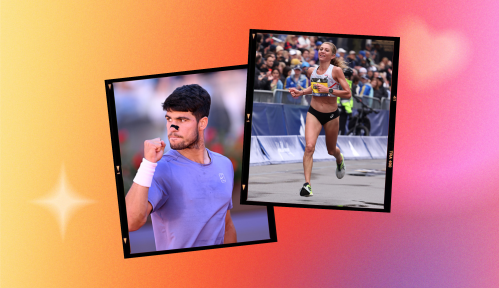I Ran a Mile for 31 Days Straight—Here’s How It Affected Me
Running a mile every day for one month helped me get unstuck and allowed me to practice discipline and achieve a short-term goal.

Peanut butter whiskey stung the back of my throat as it had on the way down, this time on the way up. I scanned the suburban sidewalk: Whose lawn would be better to puke in? It was a Sunday morning, August 1, and I was running.
I hated myself for it. I hated the celebratory drink I took at a friend’s housewarming barbeque the night before, hated myself for the cheeseburger I ate with chips and guacamole, hated myself for running at 10:45 a.m. rather than earlier, the Texas sun already blazing. Mostly, I hated my own weakness. Half a mile in and already looking for somewhere to puke.
I stopped running. I stared at my own feet, immobile. It felt like failure. It was failure.
Around me, brick homes painted the picture of American domesticity, a Kia Sorento in the garage, crepe myrtles along the driveway. Men in Crocs fired up lawnmowers. Women swung garden hoses. They looked neither happy nor unhappy. Their faces mirrored my own: Sweaty, resigned, hiding the guilt about their own exhaustion.
Languishing has defined the past year, for me and arguably for everyone else. We all know the feeling: Stagnant. Stuck. Most days pass in a blur of emails and dirty dishes. Did I go anywhere? Not really. Did I accomplish anything? I’m not sure. Shouldn’t I be over this feeling by now? There are plenty of options for things I could do—make new friends, write, volunteer—but I’m too busy thinking about all the things I should do. (Make new friends, write, volunteer.) It’s paralyzing. To make matters worse, the effects of languishing are collective as well as individual: We’re all caught in the mud. No one has a rope to pull us out.
This summer, sick of fighting through the malaise, I made a decision: Enough. No more languishing. It was time to get unstuck.
But how? I needed something to throw myself into, something to strive toward. The act of running—hurtling forward, leaving the past behind—seemed suddenly appealing. Never mind that I hate running. Other people like it. Ambitious people run. Successful people run. The sidewalk is available and free to use. How hard could it be? The first time I ran, I made it to the end of my neighborhood street before seeing spots. A fitness app blinked at me, “Done already?” I’d made it less than one-third of a mile.
In July, a friend offered a suggestion: Try running as slowly as you can. Take baby steps, shallow and short. See how far you get. To my utter astonishment, it worked. In the last week of July, I ran the first mile I’d ever completed in my adult life. I sat on the curb in a sports bra, covered in sweat, wiping tears from my eyes.
Why does achieving goals feel so good? Social scientists call it the progress principle: Completing meaningful, short-term goals allows you to feel a sense of progress. The more you feel like you can make progress, the more you will. Small goals can be a way to get unstuck.
So if one run felt good, more would feel better. I set a new goal comprised of small goals. In August, I would run one mile per day, every day. 31 runs, 31 miles. It seemed so simple, so achievable. I would march forward. I would move.
Small goals can be a way to get unstuck.
Then I sipped that peanut butter whiskey on July’s last Saturday night. August arrived with a harsh truth: Moving forward was going to hurt.
Every one of my runs was painful. My shins, my calves, my ankles. I sought downhill routes only to discover new places for the pain to hide, behind my kneecaps and along my hamstrings. There is no cheating the act of running. It’s your feet against concrete. That’s it.
But I finished. I ran every day, only pausing on that first day of August. Along with the aches, completion brought comfort. What did I do today? I ran one mile. Why? To reach the end. Who decided the end? I did. It was one mile away.
Too often, exercise is presented as another item on the endless to-do list of “wellness.” It’s a project we can work on all the time, and therefore should work on all the time. Having a coffee? It could be green juice. Taking a walk? It could be a sprint. Splitting pizza with a pal? You could be at SoulCycle. The pressure is constant.
Modern exercise culture, awash in Peloton ads, Alo Yoga tank tops, and Outdoor Voices spunk, “[demands] women control their bodies and treat them as our primary projects—to be tweaked, molded, and perfected forever,” writes the author Danielle Friedman. The work of improving yourself is never done.
The trouble is, without an end goal—a distinct result to achieve—there is only more, more, more, which paradoxically results in so much less devotion of ourselves. Why not take a day off from a project that could conceivably last a lifetime? Why not finish that Netflix series? When nothing is defined, nothing is at stake. A goal as vague as “I want to look good,” or “I want to get in shape,” leaves you with nothing but opportunities to fail.
While I ran, I thought of this quote from author Anne Lamott: “Discipline has been my path to freedom.”
Discipline is limiting. In our frictionless, on-demand world, limitations are extremely helpful. During the month of August, I couldn’t hold myself responsible for accomplishing everything I wanted to do. I couldn’t go to a dozen dinner parties, finish War and Peace, or prepare my tax returns. I had to run. Without the possibility of doing everything, I could commit to doing something. For the first time in a long time, I slept without guilt: I said I would run, then I did. That was enough.
Setting goals isn’t just the act of assigning priorities. It’s the act of eliminating optionality. It’s about making choices.
The effort of choosing to do a hard thing, then choosing it again, and again, and again, is the real workout. Its purpose is not to achieve lean calves or glistening abs, but to earn your own self-respect. It can be done in any number of ways. Learn to whittle. Grow a tomato from seed. Paint. Land an ollie on a skateboard. Pick something to work on, and work at it every day. Discover you can accomplish hard things. Trust in your own perseverance.
When the world’s challenges appear, you’ll be ready. “I did that,” you can say, pointing at your track record. “I can do this.”










